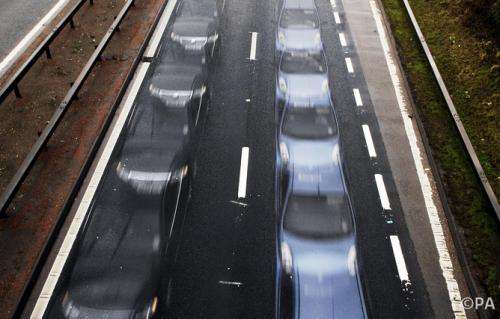Self-driving cars could be the answer to congested roads

If cars with drivers still suffer under gridlock conditions on roads, how will driverless cars fare any better? With greater computerisation and network awareness, driverless cars may be the answer to growing traffic congestion.
In the UK there are plans to allow driverless cars on public roads by 2019, with the testing of self-driving cars in controlled conditions to start next year. For many reasons, besides reducing pollution and traffic congestion, Britain's roads would be a .
According to Gartner's 2014 for , autonomous vehicles are currently reaching what it calls "the peak of inflated expectations". While enthusiasts wait for a revolution of the kind , the chances are that the technology behind driverless cars will arrive gradually. First in luxury cars as items of safety and comfort, then in the automation of heavy off-road vehicles (such as in mining and agriculture) and finally in averagely priced cars for the rest of us within the next 10 to 15 years.
Before that can happen the technology must be consolidated and miniaturised, and the laws and updated to reflect these changes. The lack of traffic regulation for experimental driverless cars is a barrier – and current research aims to establish not only ways of controlling driverless cars but developing the systems through which they can share the roads.
A car with situational awareness
Researchers at the High-Performance Computing Laboratory () at the Federal University of EspÃrito Santo in Brazil, have developed the (IARA). The car is a hybrid SUV equipped with computers in its boot, sensors such as and a on its roof, and is equipped with a .
In order to self-drive, IARA processes many gigabytes of data from its sensors in real time, generating a map on the fly for planning the route to any given destination. It then translates all this data into commands to control the vehicle, while avoiding obstacles such as other cars and obeying traffic signals.
Helping cars see as we do
While some engineering focuses on building faster and cheaper sensors for cars, LCAD's robotics team examines how our brain gives us visual cognition of the objects in the world around us. Understanding this will provide a clearer idea of how to program driverless cars to "see" and recognise the roads and other vehicles.
This is because the images from a digital camera, regardless of its quality, are just a bunch of numbers organised in a matrix. Giving computers the ability to understand what these images represent may help them comprehend the world visually as we do. These are the computational models that go into IARA for testing. Also to be tested in the near future is an , which will make it possible for people to control IARA over the internet using only thoughts.
LCAD in Brazil is working with City University's to investigate how the latest advances in neural computing, based on the integration of deep learning and reasoning models, can be applied to autonomous vehicles. This puts theoretical models of the brain into a practical application in the real world. The models we've investigated include computational models of , which work well with the sort of data that IARA's sensors generate. We think that just as humans learn from examples, driverless cars need to learn from data to cope with dynamic, real-world traffic.
The future of traffic
Growing traffic congestion and pollution problems will not be solved by simply expanding the road network, but autonomous and connected cars could contribute to by communicating their position, speed and the condition of traffic around them to other cars and traffic control centres.
A future that is network aware will certainly put great demands on public roads. Steps in the right direction have been taken, with organisations such as and the opening their data to the public. Ultimately, managing these wireless networks and the huge amount of data they transmit will benefit both commuters and traffic control, with better flow and higher average speeds.
Source: The Conversation
This story is published courtesy of (under Creative Commons-Attribution/No derivatives).
![]()


















